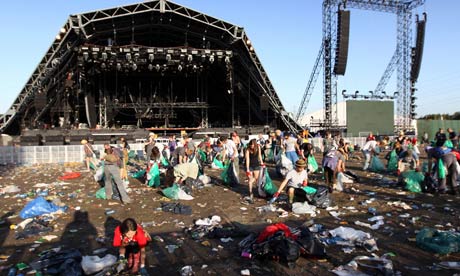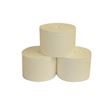Glastonbury cleans up with cleaning supplies
27 June 2011
With the party now over Glastonbury starts the clean up operation and gets out the cleaning supplies
With over 150,000 people at the Glastonbury festival at any one time you can expect the clean up operation at the 600 acre farm to be a big one.
The clean up is likely to take around two weeks with 500 staff alone on litter picking duties to clear away rubbish left behind by revellers. The fields are usually occupied by 350 cattle who were moved to a quieter end of the site whilst the festival took place.

The man in charge of the cleansing operation, Andy Willcott, said today: "It's the same as always. We are trying to return it back to being a farm again.
"The priority is not sending waste to landfill and recycling as much as we can. The majority of waste is removed after the festival.
"We have a few volunteers but a lot of paid staff. The vast bulk will be gone in the first week. It will then be a finer and finer litter pick.
"As the grass grows back more things will surface - mainly things like bits of paper from trampled paper cups. It will be looking a lot better after two weeks."
The festival management have employed a "Green Police" team responsible for trying to stop people urinating on the ground and upsetting the water table.
This year management laid on an impressive 3225 lavatories across the site. Staff now have the huge task of cleaning these portable loos with cleaning supplies and deep cleaning toilet cleaners and descalers. Ensuring that they are clean and fresh before they are sent back to the hire companies.
By installing more loos the organisers are hoping that the water table will not be adversely effected.
Their website says; "Use the toilets provided - don't pee just anywhere, the ground really can't take it. Remember there are 150,000 people at the Festival and all that urine goes straight into the water table and into rivers and streams for miles around.
"It isn't good for the ground and it isn't good for the fish! If you are caught peeing you run the risk of being expelled from the Festival, or at least being very publicly ridiculed by the Green Police! There will be more toilets than ever and they will be a lot cleaner too."
Smokers are also encouraged to use "butt bins" as one cigarette can contaminate up to eight litres of water.
Besides the toilet cleaning operations. Fast food portable outlets will be using their cleaning supplies to clean down the kitchens and serving areas after such intensive use and traffic over the last few days.
In total an expected 1600 tonnes or waste will be collected and an anticipated 48% will be recycled.
The festival is renowned as an often muddy and dirty environment especially with the sheer number of people congregating in a relatively small space. This year has seen the Wellcome Trust and Guerilla Science set up an immersive Decontamination Unit at the Shangri-La field.
The idea is that a "virus" will break out and spread through touch contaminating all who contact with it. This will highlight just how quickly the population of an area can become infected with germs, viruses and harmful bacteria. Maintaining a regular programme of cleaning using tested cleaning supplies and the appropriate bactericidal cleaning product will significantly reduce the bug count in a given environment.
Invisible UV paint was used to demonstrate a visual tool to infect thousands of people, creating two groups, those contaminated and those clean. The Decontamination unit allowed party-goers to achieve purity, cleanliness and salvation.
Those entering were surrounded by footage of viral outbreaks and microbiologists assessed the contaminated revellers.
Those cleansed were dressed in a biohazard suit and sent for physical purification. After making their way through the cleansing chambers, the purified moved through to the second level of Shangri-La, having escaped the world of filth, embarking on a brave, clean new world.
The Shangri-La's creative director, Deb Armstrong explained "This year I wanted to bring some scientific content to Shangri-La - give the narrative a bit more meat. There are so many interactive artistic installations that are very creative, but to bring actual science into the fold is altogether different, and rarely done".
Dr Amy Sanders, of the Wellcome Trust, says, "When I first started thinking about where we should take the Wellcome Trust Dirt season, Glastonbury seemed an obvious choice: organisers and visitors have to deal with copious mud and dust, limited showers and loos, and numerous humans (and their germs) in close proximity.
"It's one of those rare occasions when most of us are confronted with our own, and others', bodily dirt - what better place to get people thinking about our complex relationship with it?"









